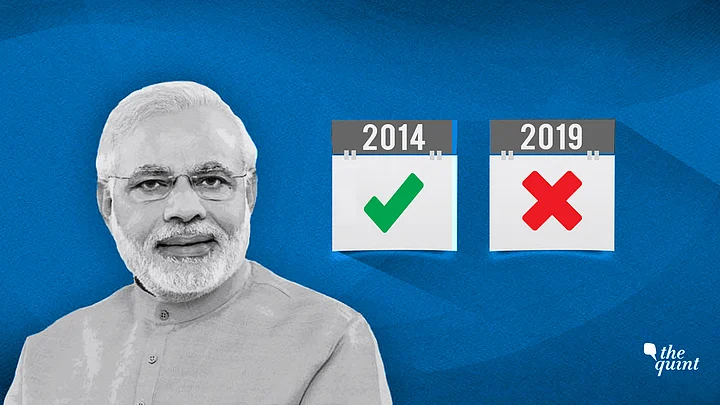It is by now clear that two things must happen for the Bharatiya Janata Party (BJP) to have a realistic shot at forming the next government. First, the national scope of the 2019 parliamentary election must alter the anti-BJP mood, as the Hindi belt has revealed in recent assembly elections (also, recent parliamentary by-elections). This does not happen usually.
The momentum rarely reverses; it accelerates in fact. Second, the party must match, if not beat, its best ever showings in Andhra Pradesh, Kerala, Odisha, Tamil Nadu, Telangana and West Bengal.
Modi’s Image Yet to Lose All Its Sheen
Neither is going to be easy for the BJP. There are formidable regional formations, a galvanised Congress, the disappointments with the Modi sarkar and its own organisational limitations in the south to contend with. However, were these to happen in 2019, the BJP, à la 2014, would have thumbed its nose at election pundits and achieved another historic result.
And once again, like in 2014, the BJP is looking at Modi to deliver, to differentiate the parliamentary election from the local in the Hindi belt, to set the tone for its pitch elsewhere.
Modi is, at one level, an unexceptionable choice. Notwithstanding the jaded notes he has been striking lately and the baggage of claims diluting his credibility, he remains his party’s strongest campaigner, still capable of striking a chord or two with the electorate. And Modi’s political savvy and propaganda machinery have insulated him just enough from the flak his government has (deservedly) faced, to remain a force to reckon with.
BJP’s Very Own ‘Frankenstein’?
That said, it is important for the BJP to reflect on whether its present political vulnerabilities owe to the very man it has reposed faith in to steer it out of trouble.
If it were not for the over-ambitious promises Modi had made, the hegemonic designs and aggression with which the BJP under him has alienated allies erstwhile and prospective, and the hasty, sweeping decisions that he is perceived to have driven without counsel, the BJP may have been more comfortably placed for 2019 than it currently is.
After all, it had much going for it. A measure of popular support and a sagging opposition when it started off in 2014. Plus, a sizeable war chest and a well-oiled party machinery in the Hindi belt.
In cricketing terms then, the BJP resembles a team that is now looking at a star player who has botched up a comfortable chase – not rotating the strike enough and miscuing once too often – to see it through in the final overs.
BJP & Opposition Will Have to Stretch Themselves to the Fullest
Heroics will cement the star’s reputation as a master finisher. Failure will spark questions. About attitude, about judgment calls. It is a precarious line for both star and team to be treading, especially at a time when the opposition, sniffing a chance after going through the motions during a large part of the contest, has developed a spring in its step and is finding some late juice in the wicket.
A mid-course change at the crease is going to be disorienting and risks sacrificing a proven if slipping quantity with an under-prepared one. It is highly unlikely then that the BJP will seriously consider an individual other than Modi fronting its 2019 bid, the tentative build-up around Nitin Gadkari notwithstanding.
As with cricket teams (which have the luxury of coming back in the next match, the next series), so with political parties. But the political arena has larger stakes, and 2019 is too crucial a battle – both for the BJP, and the Opposition – to give up on, without stretching themselves to the fullest.
What Next for Modi Sarkaar?
So, once the numbers are in, expect a fresh round of partner wooing and counter-wooing to begin. It is then, perhaps more than the elections themselves, that the BJP could find the Modi years pinching the most.
For, at the moment, there is a not a single party capable of mustering twenty-plus seats that the BJP can confidently claim will stand with it.
(By all accounts, any party with coalition-nucleating ambitions will need the support two or three such parties.) The risks of associating with the BJP and its failures, and giving it a window to cement itself in the state theaters are too high.
What will actually happen in the post-election scenario is, of course, unpredictable, but a non-BJP government or a Modi-less BJP government are no longer scenarios that can be dismissed. There could be few greater ironies than the latter materializing after a vote solicited in the name of a Modi sarkaar. It will be a sign of not only how much Modi has dwarfed the party, but also of how political exigencies can make even the most powerful expendable and how costly over-reach can prove.
(Manish Dubey is a policy analyst and crime fiction writer, and can be contacted at @ManishDubey1972. This is an opinion piece and the views expressed above are the author’s own. The Quint neither endorses nor is responsible for the same.)
